hoarding on site of 141-143 Whitechapel High Street
hoarding on site of 141-143 Whitechapel High Street and former Aldgate East underground entrance
Whitechapel High Street frontage between Goulston Street and Middlesex Street
Contributed by Survey of London on July 6, 2018
The site at the High Street’s western extremity is a scene of long-standing dereliction, notable for the overgrown remains of the original Aldgate East station visible through gaps in the hoardings. From the 1680s to the 1880s it had nine shop-houses, two at the west demolished for the widening of Middlesex Street in 1883, five at the east for the building of the original entrance to Aldgate East in 1884.
That and the remaining two houses were damaged beyond repair in the Second World War, the remains cleared in the 1950s, replaced with single-storey shops demolished in the late 1980s. The usage of this portion of the High Street is unusually well recorded.
Before the street improvements of the 1880s, nine houses occupied the frontage, bracketed following the creation of Goulston Street in the 1680s by inns at the corners of Goulston Street and Petticoat Lane, the hinterland occupied from the sixteenth century and probably earlier by Boar’s Head Yard, with an entry to it between two houses (see xx). At the eastern corner, probably from the creation of Goulston Street in the 1680s and certainly by 1730, was the Coach and Horses, part of the residual Goulston estate. As the name suggests it was a coaching inn, offering the commuter daily trips to and from West Ham in the 1760s.1 The remainder of William Meggs’ 1000-year lease of 1595 of the inn and three (later two) houses adjoining in Goulston Street was acquired in 1780 from John Burnell, buyer of the Goulston estate in 1776, by Henry Pedley, part of a family of cordwainers with substantial holdings around the High Street into the twentieth century.2 In 1802 the landlord, Joseph Walker, gave evidence at the trial for high treason of Edward Marcus Despard, who had met in the Coach and Horses with his fellow conspirators in a plot to assassinate George III as a prelude to a popular uprising; Despard was executed in 1803.3 In 1807 the inn was described as ‘a substantially built roomy house and wine vault’ with ‘spacious double- fronted liquor shop’.4 In 1867-8 the pub, with ‘a large and lucrative counter trade’, was rebuilt ‘with great taste and judgment’, but on the same small scale and renamed The Clock House, by Joseph Pedley’s lessee, the licensee Edward Wells Russell, only to be demolished in 1884 for the entrance to Aldgate East station.5
The new building, although set back from the High Street to align with the new tube-entrance building, was substantial, its site including the two adjoining houses in Goulston Street where it had its main frontage. It was a typical ‘railway tavern’ of the period, three storeys over basement of stock brick with large windows and liberal cement dressings, and a glazed frontage to Goulston Street. It was built in 1885-6 for the brewers Truman & Hanbury, mortgagees of the former owner, to the designs of George Low (1824-1906), an architect much involved in railway-related property acquisition.6 The new pub took the name Aldgate Distillery and hosted a variety of social events.6 In 1892 management was taken over by Barnes & Co., with Morris Abrahams, who had overseen the transformation of the Earl of Effingham into the Wonderland, as landlord, placing adverts, written partly in Hebrew, presenting ‘their compliments to the Jewish community’, and offering wines and spirits for Passover.7 Abrahams’ brother-in-law barman, Reuben Philips, was both a Freemason and a boxing promoter, and in the late 1890s and early 1900s the Masonic Friars Lodge, a Lodge with a high Jewish membership from its origins in 1871, met in this pub. Inter alia, there was a benefit concert in 1899 at the pub for Pluto, the ‘coloured boxer who made a bold stand against Bill Fielder at the Goodwin Club’.8
In 1901 a change of tone came when Richie Thom, former manager of the Scotia Music hall in Glasgow arrived as manager - ‘Frae Glesca tae Whitechapel’ starring ‘Richie Thom, The Boss, A Scotchman of Scotchmen’, though boxing continued, along with competition snooker.9 In 1904 it became the Aldgate East Tavern and was later known variously as the Aldgate Wine Stores, Aldgate Tavern and Aldgate East tavern, before succumbing to war-time bombing, remaining as a shell until cleared in the early 1950s.10
By the 1670s just west of the site of the Coach and Horses was an alley to Boar’s Head Yard, separated by a narrow deep house, the alley blocked in rebuilding the house by 1733. From the 1740s to the 1840s it (No. 141) was occupied by a series of apothecaries and surgeons, by 1819 by Frederick Ager who in the 1830s worked additionally as a vaccinator for the Vaccine Board, established in 1808 to promote vaccination against smallpox.11 The rebuilt house still had access to Boar’s Head Yard, and title to five small cottages on its east side in 1841.12 It and No.142 next west, previously occupied by the cutler William Hems, though mostly also occupied by linendrapers in the eighteenth century, were amalgamated in 1849 as a single linendrapers, John Vaughan succeeded in the early 1860s by George Keillor Marshall till demolition in 1884.13
In the early eighteenth century the modestly sized No.143 was a glazier’s shop, then from 1748 till demolition in 1884, it housed a succession of tobacco and snuff manufacturers, the longest tenure, from 1794 to 1846, being of Joseph Pinheiro, followed by his son and daughter-in-law.14 The final occupant, Edward Toplis, recovered from bankruptcy in 1868, acquiring railway surplus land to the rear of Nos 143 and 144 when they were demolished, accessed from the south side of Boar’s Head Yard, on which he built a tobacco factory in 1884 which survived till the Second World War.15
Next west, probably on the site of the later No.144, was a house in the occupation of three generations of the Quaker Napton family, salters, from the 1660s to the 1710s.16 It was variously a grocers and linendrapers and from1802 to demolition an apothecary’s shop (Michael Colesworthy, later Samuel Cheshire), by 1850 J.G. Gorton & Sons, who moved to No. 146 when No. 144 was demolished in 1884.17
Next door were the two houses, Nos 145 and 146, that survived road widening and railway expansion in the 1880s until destruction in the Second World War. The first, site of No.145, was a house in the occupation of ironmongers for fifty years (John Ward, d. 1681 and William Grace, d. 1718) from the 1660s to the 1710s; John Ward left money to the parish church in 1681 on condition that the authorities settle debts to him for goods delivered for the rebuilding of the church in 1672-3.18 By the 1730s a cheesemonger William Cheslyn was in occupation, succeeded c. 1750 by an oil and colourman, Luke Alder, replaced once more by cheesemongers in the 1770s.
No. 145 was acquired after the death in 1853 of the final cheesemonger, Abraham Goymer, by the Great Central Gas Consumers’ Company, and part of the basement and ground floor partitioned off to house a gas governor station (a bell floating in an iron tank, to regulate gas pressure near the points of delivery).19
Goymer had acquired premises to the rear and built a stable and chaise house on the site of three tenements formerly associated with No. 146 opening on to a yard entered from Boar’s Head Yard.20 By 1860 the building stretched back 120ft, with a warehouse to the front, stretching back enfilade through a counting house, small enclosed yard, two more small warehouses and a stable entered directly from Boar’s Head Yard, with Goymer’s chaise house, stable and chaff house adjoining west with a larger yard containing a cistern dated 1733. A survey and correspondence between the gas company and Benjamin Hyam and Son, clothiers, their lessee from 1860 in the rest of the building, throws some light on the conditions of rag-trade workers at the period.21 Hyams was a substantial firm with large shops, catering mainly for children and youths, in Glasgow, Liverpool, Dublin and Manchester, but 145 Whitechapel High Street was purely a workshop. In 1860 the house extended 120ft and a surveyor found it throughout ‘very dirty, every room is converted into a workshop’, the long list of dilapidations to be attended to by the tenant.22
The building was sold in 1884 and the rear portions demolished as part of the widening of Middlesex Street and repositioning further south of the truncated Boar’s Head Yard. The shop remained in use by clothing trades till the 1890s when it became dining rooms, the upper floors a ‘gentleman’s hotel’, and later a dental surgery.23
The final occupant of the shop before the building’s wartime destruction, from 1938, was Albert’s menswear, now at No. 88 (see xx), refitting done by Frederick Sage & Co. Ltd of Gray’s Inn Road.24
The next house (later No.146) was occupied in the 1690s and early 1700s by John Obbinson, a tallowchandler who moved to ‘Lumbard Street in the Mynt’ by 1705, succeeded by Augustin Morr.25 Like No. 145, which it resembled, rebuilding in the early eighteenth century seems likely. It was in varied use in the eighteenth and early nineteenth centuries though with a mix of ironmongers (Richard Burbidge, Peter Gilbert), chinamen (William Carter in the 1820s and early 1830s offering ‘china and glass, for the East and West Indies’ to ‘merchants and captains’) and bootmakers, pastrycooks and confectioners taking over from the 1847 till 1885. Then, Gorton & Sons, chemists, made homeless by the demolition of No. 144, moved to No. 146, now a corner building following the recently widening of Middlesex Street. It was extended then or shortly thereafter to the rear to take advantage of this new exposure, the flank wall rebuilt with three shops (Nos 2, 4 and 6 Middlesex Street).
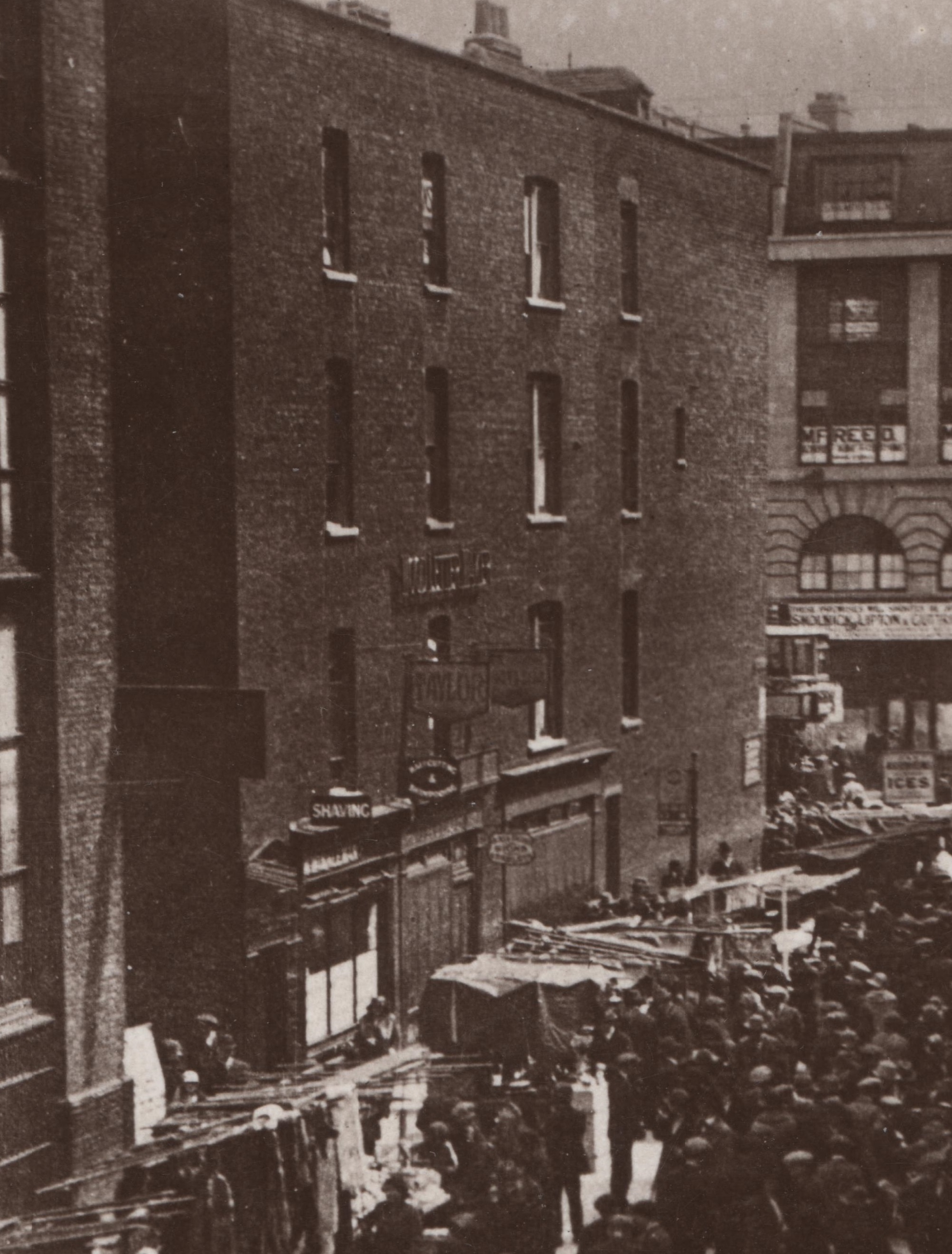
The rear of Gorton & Sons premises, as extended c. 1885 to create 2, 4 and 6 Middlesex Street, seen from Middlesex Street
Gortons remained till destruction of the building in the Second World War.26 The firm claimed on their signage to have been founded in 1720, which may have been only a slight exaggeration: Richard Gorton, chymist of Bethnal Green (d. 1787), was J.G. Gorton’s great-uncle, and that business had moved after his death to Petticoat Lane in the 1790s.27 Their building sported a large carved and gilded golden sun, emblem of the Apothecary’s Company symbolising the healing power of Apollo.28Under J.G. Gorton’s son the firm was a specialist veterinary chemists in the 1880s and 1890s, the window sporting equine memorabilia. The shop reverted to more conventional pharmacy under new owners, and remained in that trade till the Blitz.29
Between here and the Bull’s Head at the corner was a shop-house (No. 147) on a site truncated by a stable yard in Boar’s Head Yard and, at around 200 years, perhaps, the longest unbroken usage on the High Street: it was a baker’s by 1675 (Richard Tanner, d. 1696) and remained in that use until the building was demolished along with the Bull’s Head for the widening of Middlesex Street in 1883, when the final baker, Konrad Vellenzer, decamped to Harrow Road.30
Finally, at the oblique corner of the High Street with Middlesex Street (then still called Petticoat Lane) was the site, probably from an early date, of an inn known variously as the Bull Inn and the Bull’s Head. The 1666 Hearth Tax shows the corner as a small house of one hearth (1666: Richard Warde, 1675: empty), adjoining a larger one of four hearths, the presumed Bull’s Head, in 1666 in the occupancy of Adam Hill, ‘a man from the barrs’, who died in 1667, succeeded by his presumed widow, Suzan, till the 1670s.31On part of the site two goldsmiths, Thomas Hill and Samuel Embry (d. 1695), appear to have been working in the 1690s.32 The Bull’s Head is known by name in 1721 when the landlord, George England, was an agent for the York Buildings lottery.33 The licence passed at his death in 1730 to his widow Rachael who married Theophilus Thurogood in 1732, who took over the inn.34 He moved to Chelmsford to keep the Black Boy, and eventual bankruptcy. By the 1740s, under the landlord John Dawson (d. 1751) the Bull’s Head was hosting Masonic meetings.35 The Bull’s Head, like the Angel and Crown, served as both a pick-up point for those with votes in Essex, and for election rallies.36
The inn, ‘formerly two houses’, was rebuilt in brick, incorporating the small corner house, in 1788-9, when the landlord was John Peacock, but sacrificed along with No. 147 adjoining for the widening of Middlesex Street in 1883, when the building materials were sold.37
Aldgate East station original entrance (demolished)
Aldgate East station opened on the site of 141-144 High Street on 1 October 1884, the result of efforts in the 1870s by the Metropolitan and District Railway companies to complete the inner circle of London underground lines, and to connect this to the East London Railway at Whitechapel. The entrance building was set back from the High Street, a simple but dignified single- story structure in stock brick, housing booking office and stairs at the rear down to the platforms, with shallow jack arches on cast-iron columns. The M&DR’s works in 1883-4 were overseen by the engineer John Wolfe Barry.
The entrance was rebuilt forward to the High Street’s building line in 1911 in two stories, to the designs of Harry Wharton Ford, architect to the District Railway. It was clad, like several of the stations he designed (eg Baron’s Court), in buff brick-tiles by the Leeds Fireclay Company.38 A Lyons tea room occupied two shopfronts and the upper floor, lit by large shallow-arched windows, with a new open entrance to the underground to the east side. This entrance closed on 30 October 1938, the night before three new entrances opened further east.39
These shifts were necessary because of engineering work to make the curve of the line between Aldgate and Aldgate East less tight, enabling an increase in the size of trains to alleviate the congestion, which was increasing by roughly ten per cent a year between 1932 and 1936 at Aldgate East.40 At the same time entrances were opened on the south side of the High Street and the need for head room for the underpasses to these meant the tracks had to be suspended from the new joists while the track bed was excavated; the hooks are still evident.
The extended station was refitted in typical style for the New Works Programme of the London Transport Passenger Board in the late 1930s, including randomly scattered relief-moulded tiles of London and Home Counties heraldry and buildings (Houses of Parliament, 55 Broadway, the LTPB headquarters) designed by Harold Stabler (1872-1945) and made by Carter, Stabler and Adams of Poole (later the Poole Pottery).41
Postwar developments
The closure of the original entrance was followed by bombing to the whole High Street frontage between Goulston Street and Middlesex Street which totally destroyed the eighteenth-century houses at 145 and 146 and left the former station entrance and the adjoining Aldgate East Tavern derelict until 1957.
Four single-storey shops numbered 138, 139 and 141–2 Whitechapel High Street and 1 Goulston Street were erected in 1957 on the site of the station and the Aldgate East Tavern on a short-term basis till more substantial redevelopment became possible. William Clark & Partners, were the architects working for the Adamia Property Company. The largest shop was in rag-trade use, No. 139 sold records (Levy’s, which could trace its roots back to a cycle shop at 19 Whitechapel High Street which branched into importing jazz records in the 1920s, and had recording studios and shops in the West End after the war), and No. 138 shoes.42 Plans for a more ambitious office building adjoining on the site of 145 and 146 and 2, 4 and 6 Middlesex Street in 1958 were refused (because it would prejudice the redevelopment of the site after road widening at the south end of Middlesex Street), as was a scheme for a six-storey building on the corner with Goulston Street in 1983.43 The ‘temporary’ shop buildings were finally demolished in 1990 and, although permission was granted in 2008 for a 17-storey office building on the site with a hotel to the north, only the hotel portion has been built (see pp. xx) and advertising hoardings of increasing solidity have occupied the site ever since.44 In June 2018 a new planning application was submitted by Cromlech Property Co. Ltd, the owner of the site since the 1950s and now a subsidiary of Daejan Holdings Plc, and Unite Students. The proposal is for a building, to the designs of ArchitecturePLB, of between eighteen and twenty-four storeys, faced in varying shades of stock brick, to include 1,052 student bedrooms on the fourth floors and upwards, and offices below, with shops on the ground floor.45
-
London Metropolitan Archives (LMA), MR/LV/5/26: The Compleat Compting- house Companion, London 1763, p. 288 ↩
-
LMA, Land Tax returns (LT): Ancestry ↩
-
J. and W.B. Gurney, eds, The Trial of Edward Marcus Despard, 1803, pp. 92-3, 236, 257, 269, 262 ↩
-
Morning Advertiser, 03 June 1807, p. 4 ↩
-
Transport for London Group Archives (TfLGA), LT002051/474, LT002051/809-/814: Post Office Directories (POD):Morning Advertiser, 23 Oct 1868, p.1 ↩
-
The Builder, 4 July 1885, p. 370; 19 May 1906, p. 560: TfLGA, LT002051/809, /811-/813: Ancestry ↩
-
East London Observer (ELO), 13 Nov 1886, p. 5, 26 March 1892, p.2, 1 April 1893, p. 3 ↩
-
ELO, 21 Jan 1899, p. 5, 8 April 1899, p. 5, Sporting Life, 8 Dec 1899, p. 1: ELO, 20 Jan 1900, p. 5: Sporting Life, 23 Feb, 1900 p. 1: ELO, 24 Feb 1900, p. 5, 31 March 1900, p. 7, 16 Feb 1901, p. 5: https://friars.freemasons.london/about/ ↩
-
Music Hall and Theatre Review, 16 Aug 1901, p. 11 ↩
-
Daily Telegraph and Courier, 17 Oct 1904, p. 5: POD ↩
-
Report from the Select Committee on the Vaccine Board, London 1833, p. vi: London Medical Gazette, 13, 1834, pp 123-30: The Royal Kalendar and Royal and City Register, London 1835, p. 332: The British Medical Almanac, London 1837, p. 80 ↩
-
LT: Morning Advertiser, 1 Sept 1841, p. 4 ↩
-
POD: LT ↩
-
The National Archives (TNA), PROB 11/2026/63, PROB 11/1935/175: POD ↩
-
POD: LT: Ancestry: LMA, District Surveyor's Returns (DSR): Goad insurance maps: Metropolitan Board of Works Minutes (MBW), 28 Sept 1883, p. 400: TNA, PROB 11/1935/175: Historic England Archive (HEA), Aerofilms EPW055309, EAW011144 ↩
-
POD: LT: Ancestry: Gentleman's Magazine, July 1904, pp. 133-4 ↩
-
TNA, E 44/516; PROB 11/562/253: Hearth Tax returns (HT), 1666, 1674-5: Ancestry ↩
-
TNA, PROB 11/562/253: HT 1666 and 1674-5: LT: POD: LMA, Four Shillings in the Pound Aid assessment, 1693–4 (4s£) ↩
-
LMA, B/NTG/0540, CLC/B/192/F/001/MS11936/512/1078687, CLC/B/192/F/001/MS11936/526/1115690: TNA, PROB 11/2174/238: Morning Advertiser, 9 June 1853, p.8: William Hosgood Young Webber, Town Gas and its Uses, 1907, pp. 58-9: POD ↩
-
LMA, B/NTG/0540; LT; DSR ↩
-
[LMA, B/NTG/0540-544 ↩
-
LMA, B/NTG/0541, 542 ↩
-
POD: DSR ↩
-
POD: The Builder, 4 July 1884, p. 41: Tower Hamlets Local History Library & Archives (THLHLA), Building Control file 15911, location 103 ↩
-
Ancestry: HT 1666, 1674-5: 4s£ ↩
-
MBW, 11 Jan. 1884, p. 51: The Builder, 4 July 1885, p. 41 ↩
-
LMA, MS 11936/395/617316MS 11936/514/1065420: TNA, PROB 11/1151/309 ↩
-
POD: LT: Gentleman's Magazine, July 1904, pp. 133-4 ↩
-
LT: POD ↩
-
HT 1674-5: 4s£: POD: LT: Ancestry ↩
-
HT 1666, 1674-5: Ancestry ↩
-
4s£ ↩
-
Weekly Journal or Saturday’s Post, 28 Oct 1721 ↩
-
LMA, Licensed Victuallers Returns; LT; London and Surrey Marriage Bonds and Allegations, 1597-1921, via ancestry.co.uk ↩
-
John Lane, Masonic Records, 1717-1894, London 1895, p. 57 ↩
-
Morning Herald, 24 March 1784 ↩
-
THLHLA, PP/SLC/1/17/9: MBW,16 Nov 1883, p. 756: LMA, CLC/B/192/F/001/MS11936/361/557361 ↩
-
HEA, Bedford Lemere ↩
-
LMA, MR/UP/1094, MR/UP/1168: Alan Jackson, London’s Metropolitan Railway, ↩
-
TfLGA, Lt/273/047 ↩
-
THLHLA, L/SMB/G/1/38/1 and 2: John P. McCrickard, ‘LPTB New Works Programme 80thAnniversary: A Tribute to a Major Expansion of the Underground Network, accessed at lurs.org.uk: https://diamondgeezer.blogspot.com/2013/04 /aldgate-east.html: https://www.gracesguide.co.uk/Carter,_Stabler_and_Adams: Hans van Lemmen, 1000 years of tiles in Europe, 1991, p. 176: London by Design, London Transport Museum, 2016, p. 185 ↩
-
THLHLA, P14548:http://colinville.blogspot.com/2013/06/the-home-of- music.html ↩
-
Tower Hamlets planning applications online (THP): LMA, COL/PLD/AD/01/4038: THLHLA, Building Control files 15911 and 15912 location 103 ↩
-
THP: THLHLA, P14547, P14548 ↩
-
THP ↩
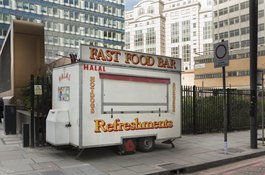
Refreshments van at corner of Goulston Street and Whitechapel High Street in 2016
Contributed by Derek Kendall
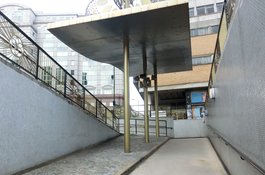
Aldgate Bars Underpass, 2011
Contributed by ddavid212
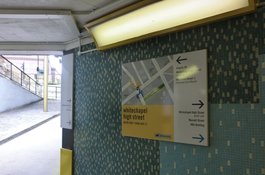
Aldgate Bars Underpass, 2011
Contributed by ddavid212
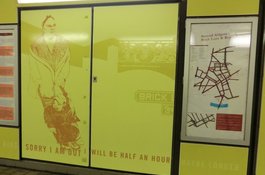
Aldgate Bars Underpass, 2011
Contributed by ddavid212
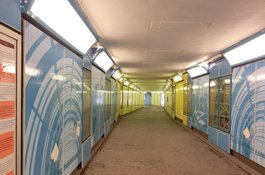
Aldgate Bars Underpass, 2011
Contributed by ddavid212
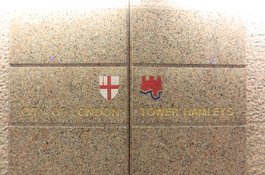
Aldgate Bars Underpass, 2011
Contributed by ddavid212
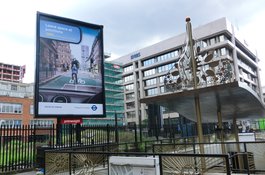
NE entrance to Aldgate Bars Underpass, 2011
Contributed by ddavid212